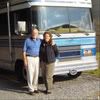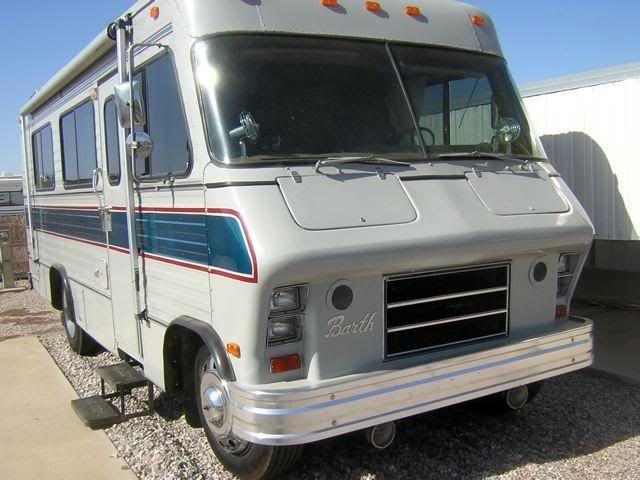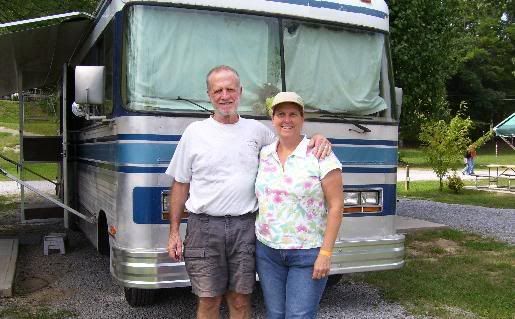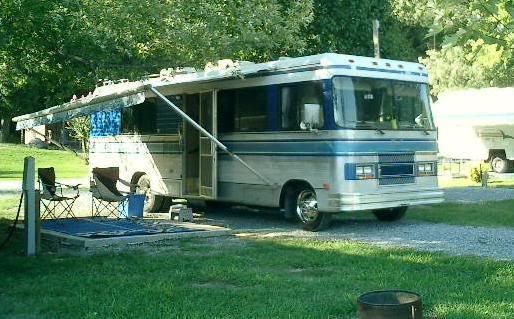Go to...  | Start A New Topic  | Search  | Notify  | Tools  | Reply To This Topic  |  |
 6/12 6/12Formally known as "Humbojb"  |
I recently saw a phrase 'Cold Air Induction'. How would one achieve this on a 454 with Quadrajet? Currently have a 3 1/2" hose from air cleaner to an air box mounted below the front bumper. Not a very clean arrangement. Jim
| |||||||||||
|
Hi Jim,...This isn't very hi-tech, but it's been working for me: The air dam baffle that extends from grille to radiator edge on pax side is apparently designed to channel ram air into the radiator - it also tends to block airflow to aircleaner inlet, and more importantly to the right side exhaust manifold & plugwires. I just cut a 6" diameter hole in the baffle, on the vertical C/L and within the top 1/3 of the baffle - that's just about in-line with the air cleaner intake snout. I have to think that this allows more cold ram air to reach the carb, but there's no measurable performance difference I'm aware of. However, it did significantly improve the heat issues I was having on the right cylinder bank. Prior to that, I had popped a couple manifold bolts and fried the two rear plug wires and boots. The hole, with its new ram air slip stream alongside the engine, cured that. In theory, I suppose I've compromised ram air to the radiator, but engine temps don't indicate that. Certainly a K.I.S.S. approach, but it worked for me.....Your mileage may vary.... | ||||
|
FKA: noble97monarch 3/12 3/12 |
Jim, Cold Air Induction was used on a lot of muscle cars in the past and generally referred to a vacuum activated flap that opened a door and forced air down into the air cleaner at speed. Some problems associated with the set up were the potential to soak the air cleaner with water if it were raining out and the possibility of leaning out the fuel mixture if used for long durations. If you decide to direct cooler outside air to your air intake, be sure to design it to dump our debris or water that may be scooped in. Without doubt, the lazy way they used to throw an air cleaner on top of the hot engine could be improved. German/Euro cars had learned a long time ago to place the air cleaner in a cooler location, and this could easily be accomplished by using a junkyard donor from something like a Mercedes, Jag, big BMW I would think. True forced air induction might have unintended consequences. Not to be confused with Lee's concept of forced air to hot parts (kinda like brake ducts on race cars). No real issues there.  Formerly: 1997 Barth Monarch Now: 2000 BlueBird Wanderlodge 43' LXi Millennium Edition DD Series 60 500HP 3 stage Jake, Overbuilt bike lift with R1200GS BMW, followed by 2011 Jeep Wrangler Unlimited, “I haven’t been everywhere, but it’s on my list.” | |||
|
| First Month Member |
Cold air induction is free horsepower and efficiency. The rule of thumb is power increases 1% for every 10 degrees F of temperature drop at the air horn. I have verified this effect on my jet boat, which has a covered engine. A jet boat with a high resolution digital tach is as good as a dyno. I normally keep the engine box lid closed, but lifting it a little lets in cooler air and away she goes! I keep threatening to run some ducts and air scoops. Anyway, I use dryer vent on my Barth. It fits over the air cleaner snout and goes down to face forward on the right side of the engine. I have used a vent jack as an air scoop, but it keeps getting damaged during off road travel, like my air dam. Some later RVs run a duct forward on top to use grille intake air, but I don't want to steal any cooling air from the radiator or my oil and trans coolers. Debris and water have never been a problem with this set up on the Barth or our Chevy PU. The P30 air cleaner has a deflector to keep debris from impinging directly on the paper air cleaner element, so what little comes in ends up just lying there. It seems to be mostly grassy stuff. I also use a dacron muff around my paper element, so it acts as a pre-filter, and can be washed easily. It gets inspected every so often, and washed if needed, but more often, I just rotate it enough to let another area get the stuff that comes in the snout. Additionally, the only time it would ever pick up much stuff is when driving fast enough for the ram air to force it up. I drive pretty slowly when off-road, so there is almost never any debris. Just a few blades or stems of grass or weeds. Cold air on hot parts is good while running, but most of the damage I have seen on MHs is from heat soak. That is, heat from the hot manifolds getting into everything after shutdown. You can see this yourself on vehicles with an accurate mechanical temp gauge. It will rise after shutdown. Or with a Raytek. A common manifestation of this phenomenon is when a Chevy is shut down, but will restart within a minute or two, but will not restart after 50 minutes. This us the heat soaking of the starter solenoid from sitting next to a hot manifold with no air flow. There is a bolt in there that gets longer when really hot, and the electrical contact is degraded. GM recognized this and came out with a special nut with a captured Belleville washer to maintain tension during heat soak. And, of course, heavy duty solenoids and heat shields help, too. This is particularly damaging if the engine is shut down right away. GM recs letting the engine idle in neutral with the AC off for several minutes before shut down. This allows the fan to get rid of a lot of the heat generated from operating under a load. My own solution to that is an electric puller fan just behind the radiator. It is controlled by a thermostat attached to the upper radiator hose. It kicks in when things get hot, climbing hills, extreme boondocking, etc. It also kicks in about a minute after shutdown and runs for maybe 10 minutes. Headers help, too, because they are not great masses of cast iron that holds a lot of heat, just waiting to dump it on sensitive components as soon as that darn fan shuts off. . 84 30T PeeThirty-Something, 502 powered | |||
|
| First Month Member |
The P30 MH snout already has a flap that keeps cold air out until things warm up.
This was more of a problem with forward facing hood intake scoops. Smoky discovered that there was a high pressure area at the base of the windshield, so the real fast guys switched to rear-facing inlets, while the front facing scoops ended up being used only for appearance. (They do look kinda nifty
Factory set ups had a richer power-enrichment for CAI equipped cars. I have a sensor in by exhaust, and it still reads in the safe range with CAI. My carb is set up for my particular engine, cam, load, altitude operating range, temp range, etc. Since a carb is a carb, everything is a compromise, so CAI doesn't seem to affect fuel mixture much. Now, in a race car, which is tuned hourly for air density, etc, CAI could have an effect on F/A ratio. In the middle of writing this, I called my carb guys, (just to be sure)and they said no worries. . 84 30T PeeThirty-Something, 502 powered | |||
|
Captain Doom |
One thing that turbodiesel owners do is let the engine run at idle until EGT drops to 300° or lower; this is to prevent cooking the oil in the turbo galleries. This is also something gaso engine operators could do - let the engine run for a couple of minutes before shutdown - this will significantly cool the engine and would reduce heat issues. Rusty '94 28' Breakaway: MilSpec AMG 6.5L TD 230HP Nelson and Chester, not-spoiled Golden Retrievers Sometimes I think we're alone in the universe, and sometimes I think we're not. In either case the idea is quite staggering. - Arthur C. Clarke It was a woman who drove me to drink, and I've been searching thirty years to find her and thank her - W. C. Fields | |||
|
So if you are one of those people who has to have the ac on if it is 70 degrees or more, (i am not. | ||||
|
 6/12 6/12Formally known as "Humbojb"  |
Lee, could you take a pic of what your's looks like? Do you have a hose of some sort coming off the snout of the air cleaner pointing in some direction? Jim
| ||||||||||||
|
Might be a little difficult Jim...My grill assembly is riveted and the subject area is all black so any pics wouldn't show much. But it's not a complicated issue anyway......See if this helps: Facing coach from front, you should have a sheet metal air dam that starts at the left side of the grill and extends to the left edge of the radiator - installed at about a 45 degree angle to the frame rails. It's purpose is to channel airflow from the grill openings to and through the radiator fins. From the front, it should block your view of anything to left & rear of the radiator. Now open up the doghouse cover....Looking down on the air cleaner, my intake snout is at about the 2 o'clock position, sitting over the right bank manifold - I'm guessing yours is there too. Envision a straight line from the intake snout to the backside of the sheet metal air dam - should come out in about the upper third portion of the air dam. Remove grill, mark center point of a 6"+/- diameter circle on air dam, and cut out w/ sabre saw & metal blade.....(smooth out cut w/ file so it doesn't bite you in the future Standing in front of coach, looking through new hole, you should now easily see the cleaner intake snout, as well as exhaust manifold, some plug wires, etc. This whole area now receives cold ram air from the new hole. I do not have any hoses or ducting installed, as cold air to carb was a minor secondary goal for me. Primarily I was attempting to get enhanced airflow over the right engine bank and help breakup any temp stratification issues. In my case, this simple mod made a significant difference. Even though I've second-guessed the original GM engineers regarding airflow & temp control, I haven't noticed any negative affects yet......and if I do, worst case scenario would be to rivet a sheet metal patch over the hole...... Obviously not rocket science, but shoot me a PM if I can explain myself better...... | ||||
|
| First Month Member |
Well, ya know, the GM engineers second-guessed themselves, too, when they added the "Splash Shield" on the right side to correct the poor air flow there. . 84 30T PeeThirty-Something, 502 powered | |||
|
Glassnose Aficionado |
Been following this thread all along, and wondering where the "Euro" engineers got the bright idea to close off the entire front of the radiator to any air flow. I haven't had much engine overheating issues, but I want to do something about the right side lack of air flow, both to keep the spark wires from frying and maybe help the vapor lock issue.  79 Barth Classic | |||
|
| First Month Member |
Does yours have the right side splash shield? It directs the air so it exits after it flows over the badk of the right side of the engine. This eases heat damage to the right rear plug lead and the back end of the manifold. That is the bolt that breaks, or where the manifold cracks.
An electric fuel pump back by the tank helps a lot. Have you seen the GM bulletin on MH vapor lock? . 84 30T PeeThirty-Something, 502 powered | |||
|
 |
Just noticed how much the front of a 81 Euro 28 looks like the 82 MCC 35... _________________________ The 82 MCC {by Barth} is not an rv-- it is a Motor Coach!! | |||
|
"Host" of Barthmobile.com 1/19 1/19 |
Looks like they eventually changed it around. This is a 1984 Euro with an 8.2L Detroit.  So far, this is the only instance where I've seen corrugated sides on a Euro.
| |||||||||||||||
| ||||||||||||||||
| Powered by Social Strata |
| Please Wait. Your request is being processed... |
|
This website is dedicated to the Barth Custom Coach, their owners and those who admire this American made, quality crafted, motor coach.
We are committed to the history, preservation and restoration of the Barth Custom Coach.
We are committed to the history, preservation and restoration of the Barth Custom Coach.





